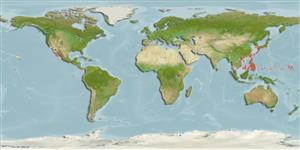>
Gobiiformes (Gobies) >
Gobiidae (Gobies) > Gobionellinae
Etymology: Redigobius: Latin,. Redere = to come back + Latin, gobius = gudgeon.
More on author: Herre.
Environment: milieu / climate zone / depth range / distribution range
Ecologia
marinhas; Água doce; estuarina bentopelágico; anfídromo (Ref. 59012); intervalo de profundidade 0 - 5 m (Ref. 86942). Tropical; 21°C - 28°C (Ref. 12468); 35°N - 6°N
Asia and Oceania: Japan southward to the Philippines, Indonesia, New Guinea and Australia. Reported from Africa: south to Coffee Bay, South Africa (Ref. 2798) and Seychelles (Ref. 4343). Widely distributed over the West tropical Pacific, from Japan to the Philippines, Indonesia, New-Guinea, North of Australia, Vanuatu and New Caledonia (Ref. 87781). The Redigobius genus is actually being revised and especially the bikolanus group that should be splitted into several taxa, leading to a revision of the group distribution also (Ref. 87781).
Tamanho / Peso / Idade
Maturity: Lm ? range ? - ? cm
Max length : 4.9 cm TL macho/indeterminado; (Ref. 11344)
Espinhos dorsais (total): 7; Raios dorsais moles (total): 6-8; Espinhos anais 1; Raios anais moles: 6 - 8. Distinguished by the following characteristics: 2-3 dark spot at caudal base (Ref. 2798); Redigobius with dusky scale margins forming network pattern; side of body variably marked with series of dark brown blotches or bars, one blackish, slightly oblique, narrow bar on side of body, second blackish narrow bar present on lower half of body; four distinct dark brown to blackish spots along mid-ventral line at anal fin; second dorsal rays I,6-8; anal rays I,6-8; pectoral rays 14-18; longitudinal scales 21-27; TRB 6 1/2 to 8 1/2; predorsal scales 5-8 (Ref. 84480).
Adults inhabit creeks, rivers and brackish estuaries (Ref. 2847, 44894). Found in tidal streams (Ref. 4343, 44894). Sometimes seen upstream a short distance from the tidal zone. Feed on small fishes and invertebrates. Not seen in markets (Ref. 12693).
Life cycle and mating behavior
Maturidade | Reprodução | Desova | Ovos | Fecundidade | Larvas
Larson, H.K., 2001. A revision of the gobiid fish genus Mugilogobius (Teleostei: Gobioidei), and its systematic placement. Rec. West. Aust. Mus. (Suppl. No. 62):1-233. (Ref. 43716)
Categoria na Lista Vermelha da IUCN (Ref. 130435)
Ameaça para o homem
Harmless
Utilização humana
Mais informação
ReferênciasAquaculturaPerfil para aquaculturaEstirpesGenéticaElectrophoresesHereditariedadeDoençasProcessamentoNutrientsMass conversion
Ferramentas
Relatórios especiais
Descarregue XML
Fontes da internet
Estimates based on models
Preferred temperature (Ref.
123201): 22.4 - 29, mean 28.4 °C (based on 586 cells).
Phylogenetic diversity index (Ref.
82804): PD
50 = 0.5000 [Uniqueness, from 0.5 = low to 2.0 = high].
Bayesian length-weight: a=0.00977 (0.00442 - 0.02163), b=3.05 (2.86 - 3.24), in cm total length, based on LWR estimates for this (Sub)family-body shape (Ref.
93245).
Nível Trófico (Ref.
69278): 3.3 ±0.43 se; based on food items.
Resiliência (Ref.
120179): Médio, tempo mínimo de duplicação da população 1,4 - 4,4 anos (Fec=1,000).
Fishing Vulnerability (Ref.
59153): Low vulnerability (10 of 100).
